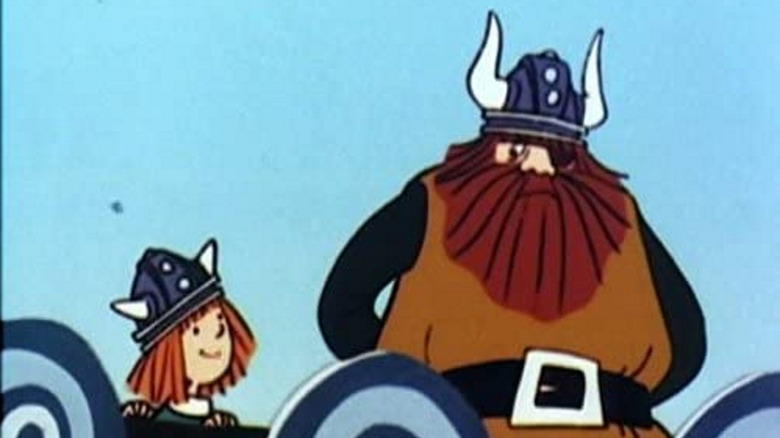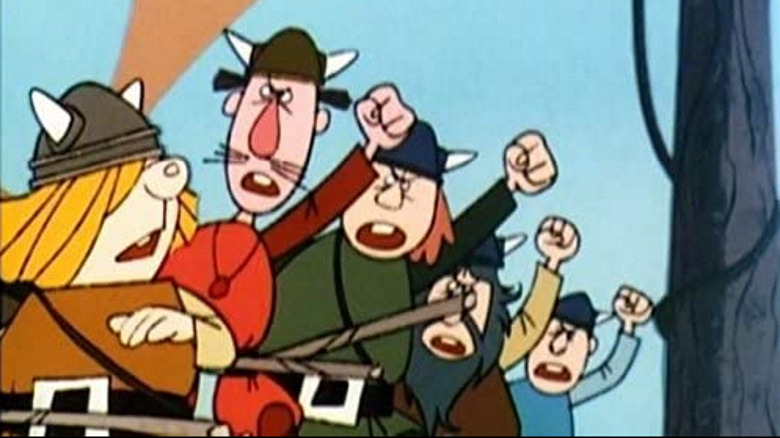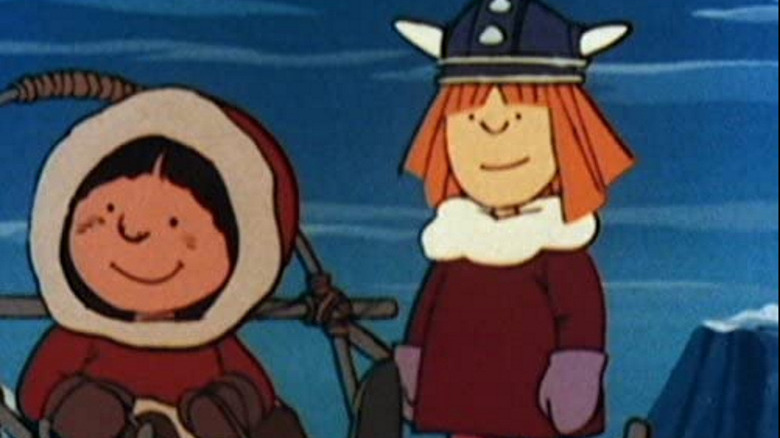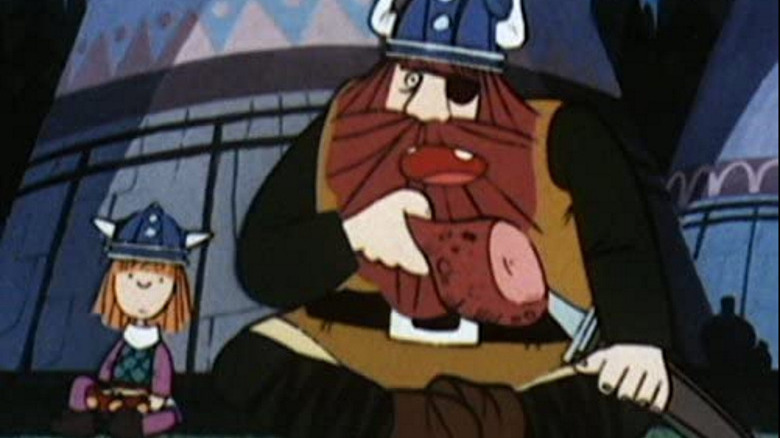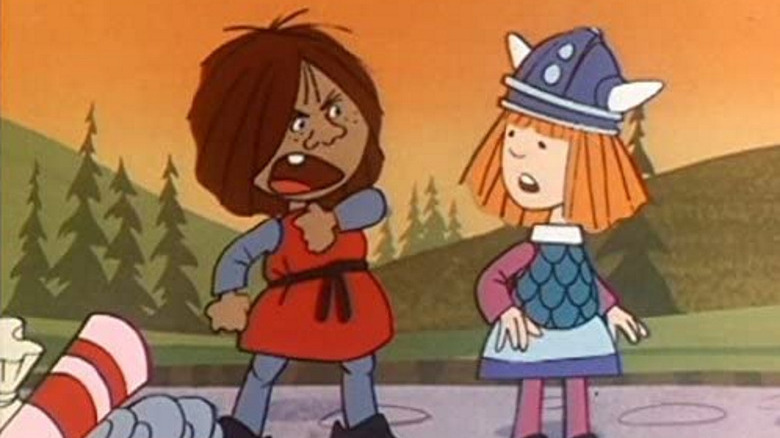The Forgotten Anime Classic That Inspired One Piece
Eiichiro Oda has drawn the Japanese comic "One Piece" for twenty-five years. Serialized via the hugely popular magazine Shonen Jump, it is now over 100 volumes long and the best-selling manga series in history. Fans and writers have dissected the influences, themes and characters of "One Piece" many times over. For instance, we know that Oda was inspired by Akira Toriyama, the creator of the mega-popular series "Dragon Ball." We know that before starting his own comic series, he worked as an assistant on the popular (and unfortunately forever tainted) historical drama "Rurouni Kenshin." But English-speaking fans may not be familiar with another of Oda's professed influences, the Japanese-German co-production "Vicke the Viking."
In an interview with the manga publisher Viz, Oda states that "as a child, I really liked an anime series called 'Vicke the Little Viking.' It was about a little kid who admires vikings, and his dream is to become one of them when he grows up." Based on the novels by Runer Jonsson, "Vicke the Viking" is a simple tale. Vicke was born in a town of hardy vikings. His father Halvar is especially large, strong and brave. Vicke is small, weak and terrified of wolves. It's hard to imagine how Vicke could ever achieve his dreams. But Vicke is crafty; in each episode, he saves his friends and family with his quick thinking. His father soon learns to appreciate Vicke's unique way of doing things. Rinse and repeat for 78 episodes of episodic japes.
Hey hey Vicke hey Vicke hey
"Vicke the Viking" aired at an important inflection point in the history of Japanese anime. According to Animation Magazine, the series was initially produced by Zuiyo Eizo in collaboration with Mushi Production, the studio founded by legendary comics artist Osamu Tezuka. The artists already had several years of experience adapting children's stories from around the world for a Japanese audience. Character designer Shuichi Seki had previously worked on the fairy tale anthology "Andersen Monogatari" (Stories of Hans Christian Andersen), per Anime News Network's encyclopedia. Composer Seiichiro Uno had contributed music to 1968's "Moomin" series. "Vicke the Viking" was another step forward, not simply an adaptation of European children's literature but instead a full co-production broadcast on Germany's public channel ZDF.
At a glance, the parallels between the vikings of "Vicke" and the pirates of "One Piece" are simple. Both travel the seas, both are portrayed as loveable goofs even though pirates and vikings are associated with pillaging. The cartoonish designs of "Vicke" are designed for humor rather than elegance or coolness; similarly, the cast of "One Piece" emote like "Tom and Jerry" characters as often as they strike the poses you would expect from traditional Japanese boy's comics. A recurring villain in "Vicke," named Sven the Terrible, shares a bushy black beard with the terrifying and underhanded Blackbeard in "One Piece."
Friendship, effort and victory
But there are additional concerns here. Oda mentions the importance of Vicke's dreams specifically, and dreams are a key component in the "One Piece" narrative engine. Luffy, the hero of "One Piece," wants to become the Pirate King. Each member of his crew has a similarly lofty ambition that leads them to travel the seas. While "Vicke" resets the expectations of the audience with each episode, "One Piece" weaves the wishes of its leads into a great tapestry. Similar to how modern superhero comics attempt to rationalize the anything-goes spirit of the Silver Age, "One Piece" develops a tight continuity out of material that would have fuelled one-off goofs in "Vicke."
In the Viz interview, Oda says that "I feel like it's awesome to have friends on your team, just like in the 'Vicke' series." Vicke is great with coming up with plans but is not strong enough to execute them himself. His viking friends will bravely do anything, but need somebody like Vicke to help them out of a jam. The two of them lean on each other, and in doing so are able to accomplish great things. Similarly, the cast of "One Piece" rely on each other to achieve their goals. Luffy is a powerful fighter who is easily fooled. Usopp is much less reliable, a habitual liar who runs away or avoids most fights — but Luffy knows that there are times when he needs Usopp, and Usopp eventually learns to overcome his fears if it means helping his friends. These themes of "friendship, effort and victory" are the guiding principles of Shonen Jump, and "One Piece" never once deviates from them, instead expanding upon them to a greater degree than any similar work before or since.
A world masterpiece theater
Dreams and friendship aside, the importance of "Vicke the Viking" lies in its status as an international co-production. The first episode of "Vicke" was aired in Germany at the end of January 1974, months before its Japanese airing. Just a few weeks before, another series produced by Zuiyo Eizo titled "Heidi, Girl of the Alps" aired its first episode in Japan. "Heidi" was directed by Isao Takahata and, according to the 3rd Edition of "The Anime Encyclopedia," featured storyboards by Hayao Miyazaki. These two men would be instrumental to the founding of Studio Ghibli, whose films would go on to be popular all over the world. But decades before "Spirited Away" won an Oscar, "Heidi" became a global success, localized for Spanish, Italian and German-language countries among others (per Jonathan Clements' "Anime: A History.")
Members of Zuiyo Eizo would later form Nippon Animation, whose productions under the World Masterpiece Theater umbrella built upon the legacy of series like "Heidi" and "Vicke." These new productions, including "The Dog of Flanders" and "Anne of Green Gables," would go on to find similar success in Europe. Today "One Piece" and its cousins in Shonen Jump serve as ambassadors of Japanese manga and anime around the world. But in earlier days, according to "The Anime Encyclopedia," "anime in Europe [was] far more likely to be known through the high-quality children's entertainment for which the WMT became justly famous."
The boy who would become a legend
"Vicke" never achieved the critical acclaim or popular adoration of "Heidi," or even its late successor "Anne of Green Gables." But it, too, made important connections outside of Japan. Its German and English-language versions were gifted with a soundtrack by late Czech composer Karel Svoboda, whose eccentric musical scoring may be the best reason to watch the series today. Svoboda would go on to compose the theme song to "The Adventures of Maya the Bee," an anime series based on a classic children's novel from Germany.
Today, anime is popular around the world. Its practitioners include traditional animators, web-trained artists and (for better or worse) enterprising fans. All owe a debt to "One Piece" and "Heidi," whose great success laid the path for future anime and comics to follow — but we should not forget the humble "Vicke the Viking." A simple cartoon it may be, born of the world before "Heidi" and doomed to live in its shadow. Although not widely remembered today, it aired on television, and Eichiro Oda saw it. Years later, the seed planted by a Swedish novelist and watered by Japanese animators would bear fruit. Seeking adventure, a young boy would cross the glittering blue ocean on his pirate ship. Legends have been founded on less.
